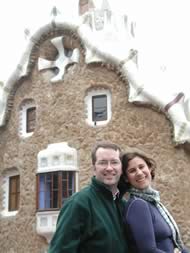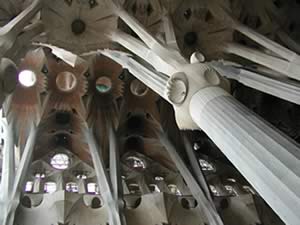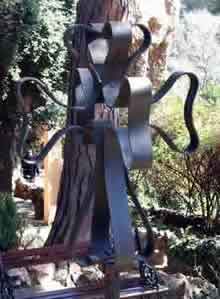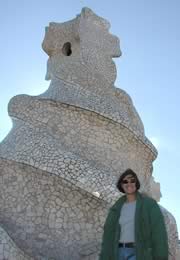This
is an explanation of why Annette chose to name her blog
(web log) after the famed architect's creative crosses.
If you haven't already taken to reading her regularly updated
blog, i can highly recommend it's insightful and honest reflections
on life and christian spirituality.
Tim Gulick |
Our first day
as tourists in Barcelona, I discovered Gaudi's cross. Tim and I
were touring the city with Ric and Frieda Escobar. Since they only
had one day to enjoy the sites, we decided to take the double-decker
tour bus that stopped at most of the major landmarks around the
city. As we drove past some of the most notable creations by the
Art Nouveau architect Antoní Gaudí, the Casa Batlló
and La Pedrera, I was captivated and glad that Tim and I had planned
a few more days in the city so we could go back and spend more time
there.

Tim
and me in front of a Gaudi designed
house at GŁell Park, Barcelona
(click
photo for bigger version)
We got off the
bus at the Sagrada Familia cathedral. Frieda wanted to go inside
and I was more than happy to accompany her. Up to that point I had
found Gaudi's architecture aesthetically appealing, but as I looked
up at the immense interior columns, whose design and geometrically
expanding form (they split from one to four to sixteen) made me
feel like I was in something built by the Elves in the Lord of the
Rings, I began to appreciate that his architecture went much deeper
than the aesthetic; his work communicates a powerful, creative,
God-centered world view.

The
impressive interior columns and vaults of Gaudi's
"Sagrada Familia" -- the only cathedral in the world
still under construction (click
photo for big version)
We didn't take
the time to visit Gaudi's workshop there at the cathedral (what
is left of it after the anarchists razed it in 1936 during the Spanish
Civil War), but I did pick up enough information about the architect
to whet my appetite. For example, high on the cathedral's towers
are lovely mosaics. When someone asked Gaudí why there was
so much detail up where no one would ever see it, Gaudí is
said to have replied, "God sees it."
 Later
that day in Güell Park, I noticed an interesting metal cross
in the garden in front of a house owned by Gaudí himself.
I stood for a few minutes taking in this unique cross. I was so
struck by the cross I knew I should have taken a picture of it,
but it was raining and I didn't have the camera on me, so I let
it go. I found this picture on-line so at least you can get an idea. Later
that day in Güell Park, I noticed an interesting metal cross
in the garden in front of a house owned by Gaudí himself.
I stood for a few minutes taking in this unique cross. I was so
struck by the cross I knew I should have taken a picture of it,
but it was raining and I didn't have the camera on me, so I let
it go. I found this picture on-line so at least you can get an idea.
(picture from
www.dgolds.com/photos)
As you can see,
its most striking feature is its dimension, the way it looks like
the intersection of two perpendicular crosses.
I had been doing
a lot of thinking about how followers of Christ can communicate
their faith in the changing cultural environment, especially how
people like me who love words, especially written words, can connect
with people who, more and more, are impacted by the visual and the
experiential than they are by written words. The answer - that we
need to be living examples of what it means to follow Christ-is
nothing new; God himself modeled it when he became a man. But in
Gaudi's cross I found an image of this incarnational apologetic.
It is impossible
to create an accurate two-dimensional representation of this cross;
it must be seen in 3-D for it to be the same cross. In the same
way, our faith must be lived or it is just a degraded copy, a thin
shadow of the real.

Here I am under another style
of 4-armed cross
on the roof of Gaudi's magnificent apartment
complex called "La Pedrera"
(the rock quarry)
The fact that
the cross was right in front of Gaudi's house told me that it had
special meaning to him. And once I had noticed it, I began to see
this "four-armed cross" on many of his buildings. I heard
somewhere that Gaudí created this cross to symbolize the
way the Gospel is ever expanding, spreading out to the "four
corners" of the globe. I love that the cross had meaning for
Gaudí, that it wasn't just an ornament (although
with his belief that the Sagrada Familia cathedral could somehow
provide "expiation" for the sins of the city of Barcelona
I'm not sure exactly what he thought happened on the cross.)
In an interview
with Vicente
A. Salaverri Gaudí said:
Men
are divided into two categories: men of words and men of action.
The former talk, the latter act. I belong to the second group. I
lack the means of expressing myself. I could not tell you about
the concept of art. I need to give it a concrete form.
|
